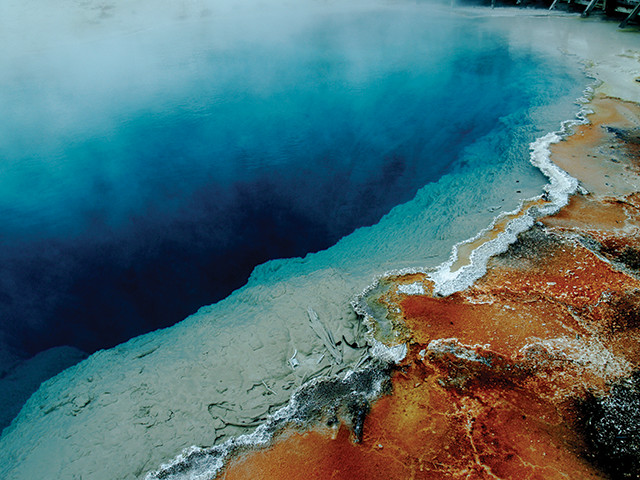
by U.S. Geological Survey Thursday, June 14, 2018
Joyce A. Ober, a mineral commodity specialist for the U.S. Geological Survey, compiled the following information on sulfur, an essential element for industrial development and crop nutrition.

Credit: Mary Caperton Morton.
Sulfur is one of the few solid elements that are found in elemental form in nature, and it has been used in industrial processes since ancient times. The Egyptians used sulfur compounds to bleach fabric as early as 2000 B.C.; the ancient Greeks used sulfur as a disinfectant; and the Romans used it in pharmaceutical applications. When the Chinese developed gunpowder in the 13th century, sulfur was an essential component. The Industrial Revolution expanded demand for sulfur used in the production of sulfuric acid, an essential component of myriad industrial processes.
Today, sulfur retains its industrial importance, and through its major derivative, sulfuric acid, sulfur ranks as one of the most important elements used as an industrial raw material and is of prime importance to every sector of the world’s fertilizer and manufacturing industries. Sulfuric acid production is the major end use for sulfur, and consumption of sulfuric acid has been regarded as one of the best indexes of a nation’s industrial development. In addition to providing sulfuric acid for use in the chemical industry, elemental sulfur is used directly as a plant nutrient, in petroleum refining, pulp and paper processing, and synthetic rubber production.
Sulfur production has changed through the years. Early sulfur miners collected sulfur from around volcanoes or used conventional techniques to mine sulfur ore. In Sicily, Italy, for centuries miners stacked sulfur ore into piles with ventilation holes and drainage ports at the bottom of the pile. The sulfur in the ore was then ignited at several locations throughout the piles, and the heat from the combustion of the sulfur caused other sulfur in the pile to melt, drain through the pile of ore, and run out of the holes at the bottom. The combustion of the sulfur ore also released large quantities of sulfur dioxide into the atmosphere. As early as 1885, the environmental damage caused by atmospheric emissions of sulfur dioxide was recognized by the Italian government, and the processing of the sulfur ore was restricted to certain times throughout the year (after the primary growing season).
The United States entered the market in the late 1800s and became the world’s leading elemental sulfur producer in 1905, thanks to a new mining process developed by German engineer Herman Frasch. Frasch was working for a company in Louisiana, trying to tap large sulfur deposits surrounding the Gulf of Mexico that were impossible to mine using conventional mining methods owing to the depth of the deposits and the geologic conditions of the area. Frasch invented a process to melt the sulfur underground and pump it to the surface; that method became known as the Frasch process. The dominance of the U.S. sulfur industry continues in the 21st century, but the primary production sources have changed dramatically: Since 2001, the U.S. sulfur industry has produced sulfur almost entirely as byproducts from environmental mitigation.
In fact, today, sulfur recovered for environmental reasons is the predominant source of sulfur worldwide. In the United States, environmental sulfur meets all domestic demand, and worldwide, more sulfur is produced, mostly from pollution abatement processes, than is consumed annually.
The sulfur industry differs from many other modern mineral industries in that the disposal of excess supplies of sulfur is becoming a more important issue than that of how to maintain sustainable production. Unlike other industries, which are searching for economical methods to produce a usable product from decreasing reserves and poorer grades of ore, sulfur producers must strive to find innovative uses for the continually growing sulfur supplies that result from pollution abatement.
For more information on sulfur and other mineral resources, visit http://minerals.usgs.gov/minerals.
U.S. elemental sulfur production was 8.7 million tons in 2009, with an additional 800,000 tons contained in byproduct sulfuric acid from nonferrous metal smelters.
The United States, Canada, China, Russia, Japan, Saudi Arabia and Kazakhstan were the top sulfur producers.
U.S. sulfur consumption was 10.1 million tons in 2009.
Although sulfur is usually yellow, its color changes with temperature, from dark orange-red in molten form to nearly white at extremely low temperatures.
Main Pass, the last sulfur mine in the United States, closed in 2000 and was located off the coast of Louisiana.
The pungent odors from rotten eggs, garlic and onions are due to sulfur compounds.
Another name for sulfur is brimstone. Sulfur was mentioned in the Bible, where Sodom and Gomorrah were destroyed by brimstone and fire. And in fact, sulfur balls and sulfur pellets have been found in the region surrounding the Dead Sea where Sodom and Gomorrah may have once existed.
Acid rain is caused by atmospheric emissions of sulfur dioxide, which reacts with water to form sulfuric acid.
Environmental protection efforts have reduced sulfur dioxide emissions so successfully that farmers now need to add sulfur to cropland to make up for the reduction of acid rain.
More sulfuric acid is produced in the United States every year than any other inorganic chemical.
© 2008-2021. All rights reserved. Any copying, redistribution or retransmission of any of the contents of this service without the expressed written permission of the American Geosciences Institute is expressly prohibited. Click here for all copyright requests.